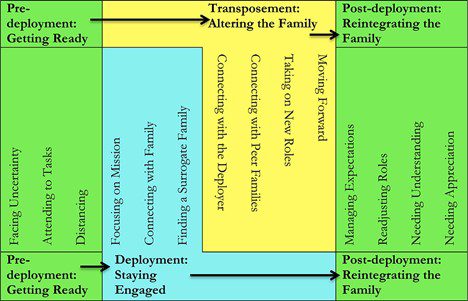By Karen Shirer, Ph.D.
Many U.S. active-duty service members have either deployed to support NATO efforts in Eastern Europe or will soon receive orders to do so. Approximately three out of every five service members who deploy have a spouse and/or children. Deployment of a spouse and parent can be one of the most stressful experiences in the military family life cycle.
Recent media reports reveal that many military families are on edge due to Russia’s war in Ukraine. My colleague, Dr. Jenny Rea, recently published a blog post on the high state of readiness military families are currently experiencing. She also provided resources and strategies that service providers can use to help military families strengthen their resilience during this uncertain time.
Deployment, like PCS’ing, leads to disruptions in military families’ daily lives. A series of transitions are set in motion that requires the family system to adapt and ensure they are resilient and ready. This work involves adapting to the absence of the deployed service member and then reconnecting with them after they return. Service providers can assist families as they work through the unique demands of the deployment process.
Drawing from the article, Hard Is Normal, the deployment process and its effects on the military family system are highlighted. Strategies and resources for service providers to strengthen family systems’ resilience are then described. Resources from OneOp and MilitaryOneSources are given for those who desire additional information and training.
Based upon an analysis of 21 research studies on deployment and military families, this paper sought to learn more about how military family systems experience the deployment cycle and how service providers can support military families’ resiliency throughout the cycle. We broadly define family systems here to include diverse forms of families we see today — married, unmarried, solo parent, LGBTQ+, and so on.
The article describes deployment in a three-phase cycle (also see Figure 1) —
1. Pre-deployment is a time of preparation and involves getting ready for the service member deployment. Both the service member and family members are involved together in this phase, although the nature of their tasks may be different. For example, the service member may have required training related to the mission.
2. The second phase has two side-by-side domains. Deployment focuses on the deployed service member staying engaged with the military mission, finding a surrogate family for peer support, and maintaining a connection with their family at home.
At the same time, transposement, which refers to the alterations in the family system, occurs as the family adapts to the service member’s absence. Family members take on new roles and responsibilities and move forward as a changed family system while staying connected to the deployed service member. The family also needs to find sources of support, including other military families, and to stay connected with the service member.
3. Post-deployment focuses on the tasks of reintegration of the family system. Effective communication helps to re-connect the returning service member to the family system. Family members also may need assistance with managing expectations. For example, the service member faces resistance when disciplining children.
Numerous research studies have shown that this is the most difficult transition for the military family system in the deployment cycle. Programs for military families on reintegration have been found to help with the process (one example is ADAPT).
The authors conclude that those who serve military families can emotionally support families by “normalizing” their experiences during each phase of the deployment cycle, thus the statement “hard is normal.”
-
- Share Figure 1 with family members and have them reflect on what the different aspects of the deployment cycle might be or are like for their family system. Another important step that service providers can take when working with military families is to help them manage rumination and worrying. Worry and guilt over the deployed service member are common.
- Encourage family members to seek peer support groups or other mental health care if these fears become overwhelming. For example, a military spouse may be worried about their spouse’s safety or feels guilt about an argument they had before deployment.
- Gently guide families toward adjusting their thoughts and feelings to more positive and affirming ones, without minimizing that these thoughts and feelings are normal.
- Again, provide information on peer support groups and other services for military families experiencing deployment. MilitaryOneSource provides information on services offered by Military and Family Support Center or through the individual services branches.
Note: A 2-page summary of this research study is available at Military REACH. It contains additional findings and recommendations for practice. A link to access the full article is given in the References section below; you may need to pay for access to the article.
Key Takeaways from this Post
-
- Deployment presents military families with transitions that need to be skillfully managed to ensure family resilience and readiness. Feelings of disruption and stress are normal.
- Research on deployment provides important information on the impact of deployment on military families and the best practices for supporting them through the process.
- Military families are resilient. Support from service providers and peers will ensure their readiness throughout the deployment process.
Call to Action
-
- Share this blog post with colleagues who support military families experiencing deployment and with friends and family members who are experiencing deployment.
- Check out the resources and research highlighted in this blog post.
- Search the rich repository of deployment information on OneOp. Two resources to get you started are Resource Discovery: Deployment Resources for Military Service Members and Their Families and Minimizing Financial Stress Surrounding Deployment.
- Plan to participate in the webinar The Relationship Changes of Military Couples During Reintegration on May 12, 2022, from 11:00 am-12:00 pm EDT. RSVP required.
- Watch for future blog posts on deployment at OneOp Family Transitions.
- Lastly, apply the recommendations in this blog post as you connect with and support military families facing or experiencing deployment.
References
Cafferty, D., Reyes, C.A.D., Beaver, S.L., & Shi, Lin. “We’ll Just Draw the Curtains!”: Military wives’ postures toward predeployment emotional preparation. Family Relations, 71(1), 389-407. doi.org/10.1111/fare.12591
Knobloch, L. K., Knobloch-Fedders, L. M., & Yorgason, J. B. (2018). Communication of military couples during deployment predicting generalized anxiety upon reunion. Journal of Family Psychology, 32(1), 12–21. https://doi.org/10.1037/fam0000344
Meadow, S. Q. Et al. (2017). The Deployment Life Study. The Rand Health Quarterly, 6(2).
Military One Source. (2022). Deployment Resources for Families.
Military REACH. (N.d.). Hard is Normal: Military Families’ Transitions Within the Process of Deployment. Research Summary.
OneOp. (2016). Parenting During Times of Transition Part 2 – Promoting Effective Parenting During Deployment and Reintegration (ADAPT). Archived webinar and materials.
OneOp. (2020). Family Systems Trends and Transitions: What They Mean For Military Families. Archived webinar and materials.
Rea, J. (March; February 22). Highlights from the 2020 DoD Demographics Report. OneOp.
Rush, D. (2022; February 22). Military Community Braces for Ukraine Deployment. WITN.com.
Yablonsky, A.B., Barbero, C.D. & Richardson, J.W. (2016). Hard is Normal: Military Families’ Transitions Within the Process of Deployment. Research in Nursing and Health, 390(1), 42-56. doi.org/10.1002/nur.21701
Writers Biography
 Karen Shirer, previous Associate Dean of the University of Minnesota Extension Center for Family Development. Karen is also the parent of two adult daughters, a grandmother, a spouse, and a cancer survivor.
Karen Shirer, previous Associate Dean of the University of Minnesota Extension Center for Family Development. Karen is also the parent of two adult daughters, a grandmother, a spouse, and a cancer survivor.
Photo Source: Pexels
















